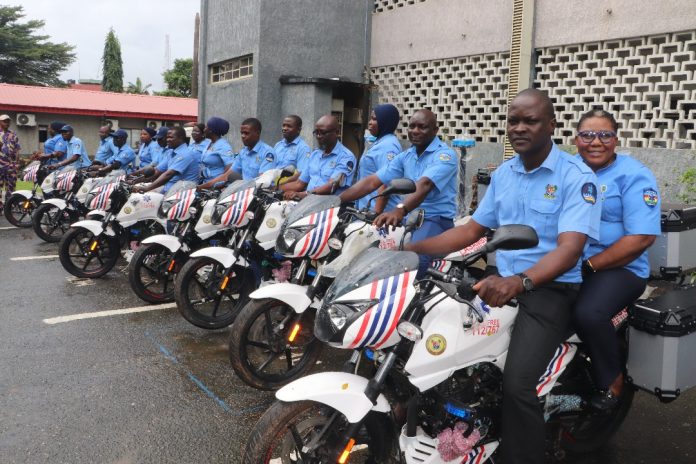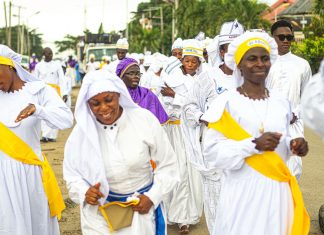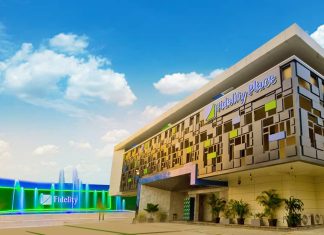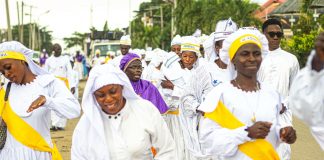*…Lagos Sets Pace with First-of-its-kind Motorcycle Response Units in Nigeria*
*…Move Targets Faster Response, Better Access, and Life-Saving Interventions*
The Lagos State Government on Tuesday unveiled and handed over 10 newly procured Motorcycle Response Unit (MRU) Ambulances, popularly called Ambulance Bikes, to the Lagos State Ambulance Service (LASAMBUS), in a bold move to cut down emergency response times and improve pre-hospital care across the State.
The motorcycles, purchased under the directive of Governor Babajide Sanwo-Olu, are designed to navigate through Lagos traffic, narrow streets, and hard-to-reach areas, thereby ensuring quicker interventions in emergencies where minutes can mean the difference between life and death.
The Motorcycle Response Units (MRU) Ambulance is a 220 CC superbike and is equipped with three specially designed aluminium storage bins, two units of sphygmomanometer, two units of stethoscope, two units of pulse oximeter, two units of portable nebulizer machine, two units of glucometer machine, AED, Forceps, Portable oxygen, two sets of EPTY protective rider boots, two sets of dukati infrared helmets, two sets of iridium portable satellite two-way radios and one unit of siren and bar light.
Speaking at the commissioning held at the Lagos State Ministry of Health, Alausa, the Special Adviser to the Governor on Health, Dr. (Mrs) Kemi Ogunyemi, described the development as another innovative step that reinforces the State’s leadership role in healthcare delivery and emergency preparedness.
Ogunyemi explained that the bikes, manned by trained paramedics, would provide immediate first aid and basic life-saving support before the arrival of fully equipped ambulances, particularly in cases of minor emergencies such as bleeding or sudden collapses where prompt treatment could stabilize patients.
“The Ambu-bikes are Lagos’ solution to the peculiar traffic challenges of a mega city,” she noted. “They will get to people quicker than the traditional ambulance, provide immediate treatment, and then call for a bigger ambulance if necessary. This way, lives are saved in record time.”
According to her, Governor Sanwo-Olu’s swift approval of the project demonstrates his commitment to quality healthcare under the THEMES+ agenda. “Once we presented the data, Mr. Governor immediately approved this innovation. It’s about access, quick response, and saving lives. This is Lagos once again showing leadership in healthcare innovation, the first of its kind in Nigeria,” Ogunyemi stated.
She further emphasized that the motorcycles were not mere transport tools but were fitted with essential emergency gadgets such as defibrillators, oxygen tanks, nebulizers, and other first aid equipment. “These bikes have everything except a bed. Our paramedics are trained to administer CPR, stop bleeding, give IV fluids, and stabilize patients until ambulances arrive,” she added.
The Special Adviser reassured residents that the move was also cost-effective, adding that “it costs far less to deploy an Ambu-bike than a traditional ambulance, yet it achieves faster response in situations where every second counts. It’s about efficiency, effectiveness, and better outcomes for Lagosians.”
In his remarks, the Permanent Secretary, Lagos State Ministry of Health, Dr. Olusegun Ogboye, disclosed that the new MRUs were part of a broader five-year master plan to transform pre-hospital emergency care in the State, with significant investments already made in mobile intensive care units, communication systems, and staff motivation.
He explained that the ambulance bikes fit perfectly into the State’s strategic plan to develop a seamless emergency response network. “With the support of Mr. Governor, we now have vehicle ambulances, a boat ambulance, and these bikes. Soon, helicopters will also become part of our emergency response system,” Ogboye revealed.
The Permanent Secretary stressed that the deployment of MRUs would help LASAMBUS officers reach victims faster, stabilize them, and prepare them for onward movement by ambulances where necessary. “The logic is simple: bikes beat the traffic, paramedics save lives on the spot, and ambulances complete the evacuation. This synergy reduces mortality and improves patient survival rates,” he said.
Ogboye added that the system is fully integrated with LASAMBUS’ communication and data platforms. “When a call comes in, the dispatch officer decides whether to deploy a bike, an ambulance, or both. The bikes buy time, the ambulances complete the task. It’s part of an interconnected system that also feeds data for planning and performance review.”
Director of LASAMBUS, Mrs. Beatrice Makinde, hailed the gesture as a long-awaited innovation, describing it as a game-changer for emergency services in Lagos. “For years, we have battled traffic bottlenecks that slow down response. With these bikes, we can now get to victims quicker, improve survival chances, and save more lives,” she said.
Makinde noted that the MRUs were versatile and could operate in environments where ambulances are impractical, such as narrow streets, crowded event grounds, and off-road locations. “This makes them vital not only for routine emergencies but also for special events, mass gatherings, and difficult terrains like Lagos Island’s old streets,” she added.
She concluded by assuring Lagosians that LASAMBUS paramedics were adequately trained to manage the bikes and deliver quality pre-hospital care. “The MRUs are equipped with life support gadgets and will be properly deployed to ensure Lagosians benefit maximally from this innovation,” Makinde affirmed.
With this development, Lagos has once again raised the bar in healthcare delivery in Nigeria, positioning itself as a model for innovative emergency response systems in Africa.


















